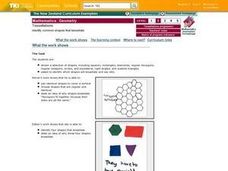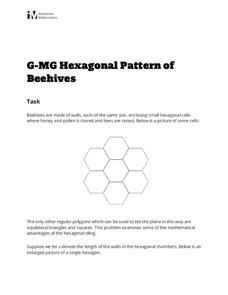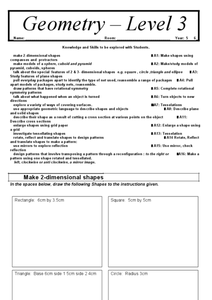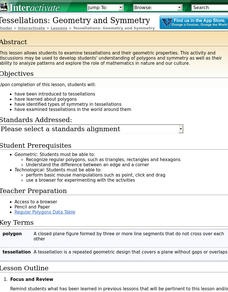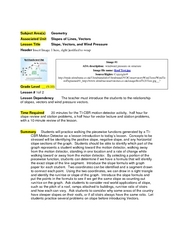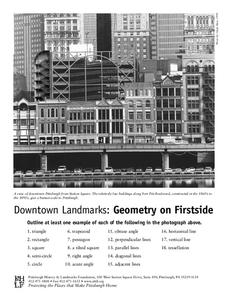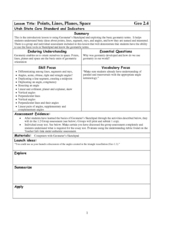Curated OER
Tessellations: Identify Common Shapes That Tessellate
Middle schoolers explore tessellations. They are shown a selection of shapes. Students identify shapes that tessellate and justify their answer. Middle schoolers create their own tessellation.
Curated OER
Geometric Transformations and Tessellations
In this geometry worksheet, 10th graders create a polygon in the indicated quadrant of a graph and perform the indicated transformation. Students create an Escher type transformation. The one page worksheet contains four...
Illustrative Mathematics
Hexagonal Pattern of Beehives
Young geometers and biologists investigate the math of nature in an activity that is just the bee's knees. Participants will study the tessellations of hexagons in a beehive, along with the natural rationale behind the specific shape....
Curated OER
Four Color Map
Students explore geometry by completing a color puzzle. In this shape identification lesson, students utilize deductive reasoning to complete a Google SketchUp puzzle with trapezoid, triangles and rectangular shapes. Students...
Curated OER
Geometry Level 3
What a wonderful resource! Learners create two-dimensional shapes according to the instructions stated, use the squares to make a triangular prism, a cube, and a pyramid, and identify features of plane shapes, among a myriad of other...
Curated OER
Chapter 19 Word Search
Here is a geometry worksheet in which learners locate and identify various vocabulary terms related to geometry. There are twelve words located in the puzzle.
Curated OER
Tantalizing Tessellations Lesson III: Creating a Slide Translation
Students watch and discuss an M. C. Escher video, use what they have learned to explain and apply their knowledge of tessellations in order to create a slide translation, present their findings in a 12" x 18" poster, and explore...
Curated OER
Tantalizing Tessellations - Lesson I
Students complete a chart (KWL) as a pre-assessment, study the history of tessellations (tilings), investigate the properties of tessellations, and make and evaluate photographs of "found tessellations" for a PowerPoint/HyperStudio...
Curated OER
Back to the Bees (Tesselations)
Sixth graders observe the creation of a tessellation with hexagons. In groups, they work with polygons to discover what shapes can be used to create tessellations and explore the angle measurements of each shape. Using internet websites,...
Curated OER
Geometry and Symmetry
Learners examine tessellations and their geometric properties. The lesson and discussions may be used to develop students' understanding of polygons and symmetry as well as their ability to analyze patterns.
Curated OER
Totally Tessellations!
Eighth graders investigate the concept of tessellations and transformations. They create patterns to demonstrate and practice the skill. Students write a description of the pattern for others to interpret. The pattern is assessed...
Curated OER
Tessel Your Way to Nagano!: Olympics, Winter Sports, Snowboarding, Graphic Design, Geometry, Math, M.C. Escher, Tessellations
Students create Post-It note fundamental regions to tesselate. They make tesselations using computer software or websites. They create a jacket design with tesselation and determine the cost of production.
Curated OER
Slope, Vectors, and Wind Pressure
A hands-on instructional activity using the TI-CBR Motion Detector to provide information to graph and analyze. The class uses this information to calculate the slope of motion graphs and differentiate scalar and vector quantities. There...
Radford University
Google Earth Trip
A trip around the world sounds nice, but for now we'll just have to make do with Google Earth. Pupils use pictures of landmarks to apply geometry concepts. They determine whether each building has bilateral or rotational symmetry, search...
Curated OER
Tessellations
Seventh graders investigate geometric shapes using tessellations. In this geometry lesson plan, 7th graders practice tessellations using different shapes. They create different designs using tessellations.
Curated OER
Mathematics in Art?
Fifth graders view prints of M.C. Escher's work. They look at examples of geometric figures and polygons and discuss places they have seen them. Students create their own tessellations. They write a report about the process they used in...
Curated OER
Recognizing Patterns
Students explore the concept of patterns. In this patterns lesson, students use applets to manipulate tessellations. Students predict the next number in a sequence by recognizing patterns.
Curated OER
Tiling the Plane
Fifth graders use pattern blocks and triagular grid paper to reivew shape names, be introduced to the concept of a tiling of the plane, and determine which pattern blocks tile the plane. They are asked if they comprehend what a...
Curated OER
Tessellation Trial and Error
In this interactive lesson, students review attributes of equilateral polygons. They are introduced to the concept of a tessellation. Using protractors and pre-cut shapes, students arrange a variety of tiles to create tessellations. They...
Curated OER
Tessellations
Students create tessellations. In this math lesson, students explore symmetry and patterns through the creation of a tessellation. Students design and create their own tessellation.
Curated OER
Tessellations
In this tessellations activity, 10th graders complete 6 different problems that include constructing various tessellations. First, they show how to tessellate a plane with a square and then, a rectangle to tessellate the same plane....
Curated OER
Downtown Landmarks: geometry on Firstside
In this geometry worksheet, students look at a picture of downtown landmarks and identify different shapes, lines, and more. Students identify 18 items.
Curated OER
Miras, Mirrors, and Kaleidoscopes!
Students use hands-on activities to explore transformations. They view a video segment that demonstrate how M. C. Escher employed geometry and transformations to create so many of his famous drawings.
Curated OER
Points, Lines, Planes, and Space
In this points, lines, planes, and space worksheet, students solve word problems dealing with points, lines, planes, and space. Students complete 20 individual problems and 20 group problems.


